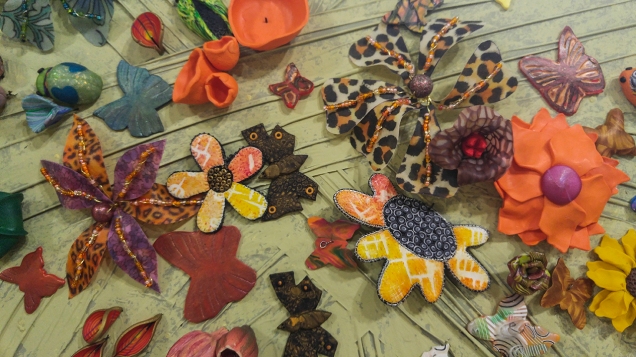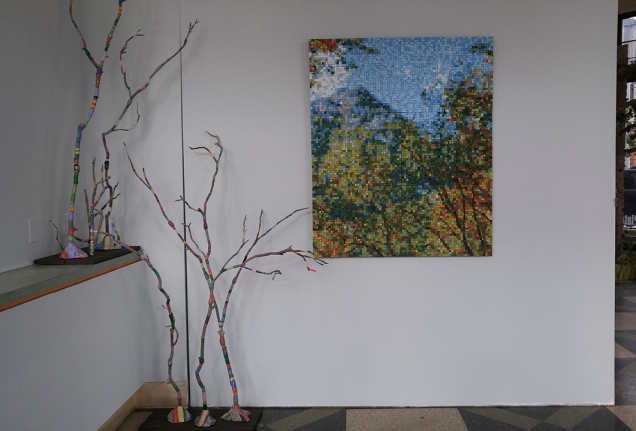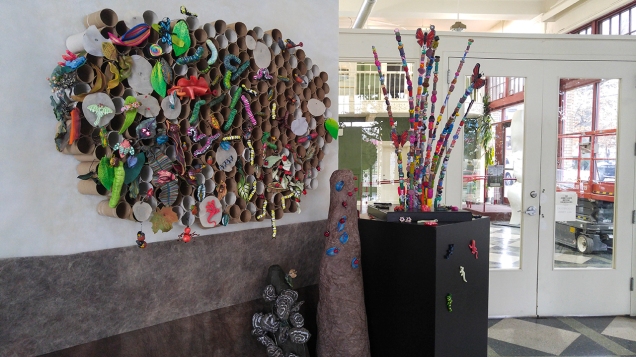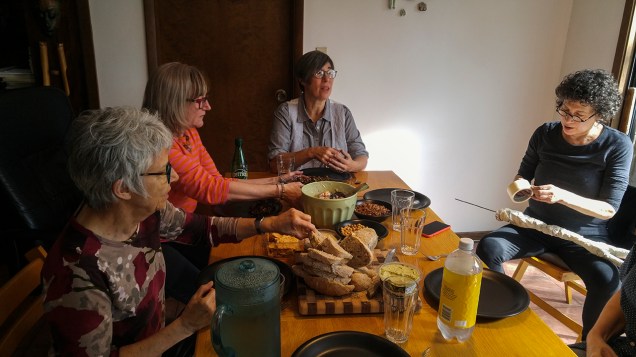Blog post by guest writer Sherri Roberts
How might one describe INTO THE FOREST, both the artwork and the experience?
 First, how is a forest “supposed” to look? While I had nature’s beauty vaguely, distantly in mind, these 300+ polymer-clay artists have grabbed nature’s expressive details from within their own environments and countries to fashion unique elements for ITF. No one set of leaves or cluster of butterflies or bouquet of dandelions was like any other. And, just to be clear, this place used to house a car dealership–lots of space to fill.
First, how is a forest “supposed” to look? While I had nature’s beauty vaguely, distantly in mind, these 300+ polymer-clay artists have grabbed nature’s expressive details from within their own environments and countries to fashion unique elements for ITF. No one set of leaves or cluster of butterflies or bouquet of dandelions was like any other. And, just to be clear, this place used to house a car dealership–lots of space to fill.
As I approached the Spinning Plate Gallery window from outside, the flowers and leaves and trees appeared to have been transplanted from a local park. Yet, immediately inside the doorway, I realized that I wasn’t “in Kansas anymore.” Reality mixed seamlessly with imagination.
 Across from the entrance, a silhouetted mountain-forest scene seemed to jump out at me from off of the wall. It was like nothing I had ever seen in nature. Yet, it was beautiful. “Look at how I am a huge picture,” the forest whispered. “But, come closer. Be mesmerized by all of the millefiori canes which house small, intricate designs of their own.” The picture reminded me of Chuck Close’s huge grid portraits, where each small square in the work holds a miniature design.
Across from the entrance, a silhouetted mountain-forest scene seemed to jump out at me from off of the wall. It was like nothing I had ever seen in nature. Yet, it was beautiful. “Look at how I am a huge picture,” the forest whispered. “But, come closer. Be mesmerized by all of the millefiori canes which house small, intricate designs of their own.” The picture reminded me of Chuck Close’s huge grid portraits, where each small square in the work holds a miniature design.
 The experience of finding the fantastic within the familiar was repeated over and over. Around the corner, I saw a group of branches almost sprouting from thin air. When I leaned in to look more closely, tiny faces supporting small tree-like totems returned my stare. In fact, I had to visit ITF a second time to catch this experience after discovering it in a photograph from opening night. But, the work took on more importance when I heard about its origins.
The experience of finding the fantastic within the familiar was repeated over and over. Around the corner, I saw a group of branches almost sprouting from thin air. When I leaned in to look more closely, tiny faces supporting small tree-like totems returned my stare. In fact, I had to visit ITF a second time to catch this experience after discovering it in a photograph from opening night. But, the work took on more importance when I heard about its origins.
A group of women crafters who were part of the Ohio Reformatory Polymer Clay Project in midwest Ohio worked with two dedicated polymer-clay artists to contribute this piece. Despite limitations in the quality and variety of tools allowed, these women completed a skilled and intricate display. The crafters compared the experience of working with the clay to their recuperation, putting small, broken pieces back together into something precious and complete.
 ITF encouraged and brought about a variety of other connections as well. Personally, I had been out of touch with local fiber people and welcomed the chance to help with scene construction. Laura and Emily were calm and focused partners who appreciated all volunteers. Every effort drew us closer both to one another and to completing ITF. Knowing this, an undertone of anticipation and excitement filled the gallery. Now look what happened!
ITF encouraged and brought about a variety of other connections as well. Personally, I had been out of touch with local fiber people and welcomed the chance to help with scene construction. Laura and Emily were calm and focused partners who appreciated all volunteers. Every effort drew us closer both to one another and to completing ITF. Knowing this, an undertone of anticipation and excitement filled the gallery. Now look what happened!